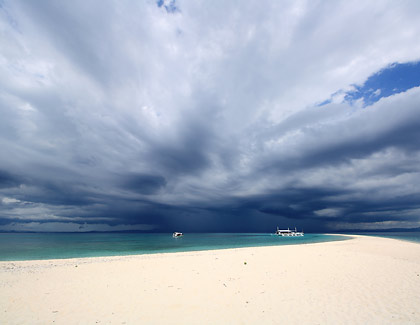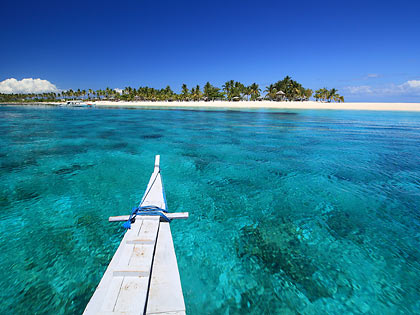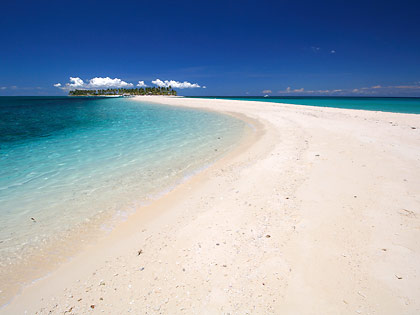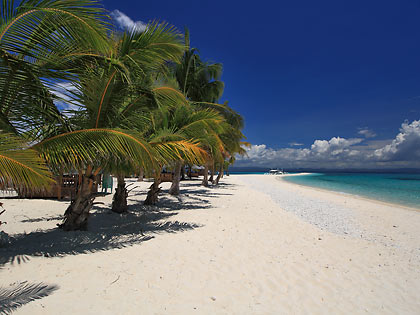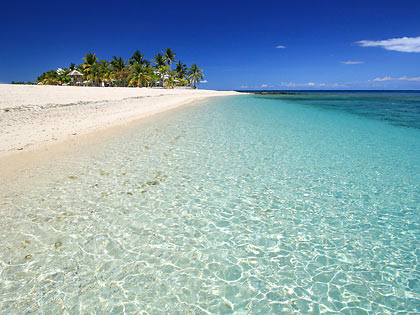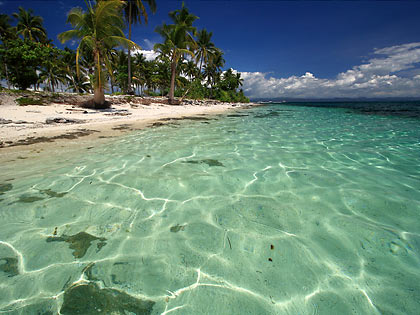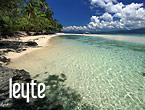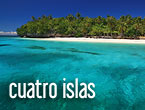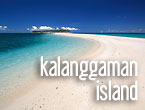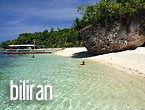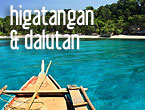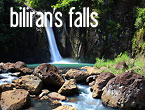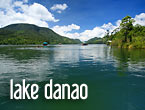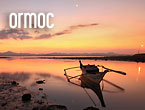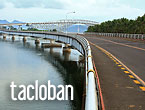Kalanggaman Island Revealed
Barely an hour after departing from the wharf at Palompon, we watched the deep blue waters of the Visayan Sea begin to transform into a crystal-clear shade of turquoise, revealing a rich growth of corals underneath. Slowly too we watched as the previously distant island on the horizon began to get larger in our sights. And there it was – a long, extended isle of verdant coconut palms and blinding white sand gleaming in the turquoise waters. After dreaming about going to this island for years we finally made it.
(For more pictures of Kalanggaman, visit our Flickr album)
A part of the municipality of Palompon, Kalanggaman Island had long been a secret among the people of Leyte. With its crystal clear waters, white powdery sand and long, snaking sandbars, this beauty was largely unknown to the outside world until in 2013 a passing cruise ship – the MV Europa Cruise Line – dropped off some 400 passengers to tour the island. It has since then been gaining a lot of publicity locally and internationally. Recently, leading sky travel advisory website Skyscanner voted it as the best of nine "amazing sandbars" in the Philippines.
Locals say however that Kalanggaman was even more beautiful before. This was when the island used to have two sandbars, not just the one we saw on our visit. (We saw aerial photos of the island still with the two sandbars a few years ago.) Both sandbars extended on either side of Kalanggaman, giving it the appearance of a sea gull when viewed from the air. When Typhoon Yolanda (Haiyan) passed through the island in November 2013 it wiped out one of the sandbars, although fortunately sparing the other. According to the local tourism people at Palompon, scientists assured them that the now vanished sandbar will be back in a few years, so long as the habagat or southwest monsoon will keep passing by and depositing sand back onto the sandbar's former location.
The beauty that we witnessed the moment we disembarked from our boat, however, was enough for us. Despite Yolanda's best efforts the island seemed to have regained its pristine state. There are no fancy accommodations, restaurants or shops on the island. There are, however, several native-style open huts for rent and we immediately headed off to one very near the base of the sandbar. In a few more minutes we were exploring the sandbar itself – a long, snaking white sand marvel. The waters around Kalanggaman are crystal-clear making it ideal for swimming. There is a certain point at the sandbar, though, where a sign warns swimmers not to proceed any further.
The side where our boat docked includes a long, sandy beach lined by coconut palms – obviously the best area for swimming. The opposite side of the narrow island, not so frequented by people, is rocky rather than sandy. After sampling the main white sand beach we explored this side and snorkeled in its glass-like clear waters. There were some fishes hiding among the rocks but the corals, as in the Cuatro Islas group of islands, were situated further out to sea. In retrospect we could have asked our boatmen to take us to deeper waters for snorkeling. Instead we decided to walk to the opposite end of the island where the other sandbar used to be.
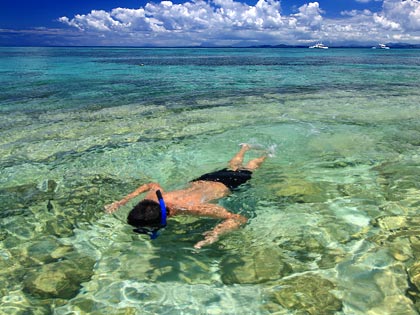
Snorkeling in the shallows at the rock-filled beach.
Kalanggaman is not a large island and it did not take long for us to reach the opposite end. Here the ravages wrought by Yolanda were more apparent. Remains of structures blown away by the super typhoon are still visible, although much had been removed and cleaned. The sandbar was nowhere to be found but the waters are crystal-clear and the sand a dazzling white as with the rest of the island. We took some time imagining how the area could have looked like before Yolanda. The locals also say that this sandbar was even more beautiful than the remaining one. After a few moments of solitude we made the trek back to our rented hut.
Kalanggaman is a place where one can relax and just enjoy the view but there are too many activities to pass up. Swimming and snorkeling are of course right up there on the list. There are also equipment available on the island for kayaking, aqua biking and scuba diving. While resting after lunch we noticed that two large dive boats have docked at the island. These were dive boats from Malapascua, the island famous for thresher shark diving in northern Cebu. Since Malapascua is just two hours away by boat, tour operators have included a trip to Kalanggaman as part of their itinerary.
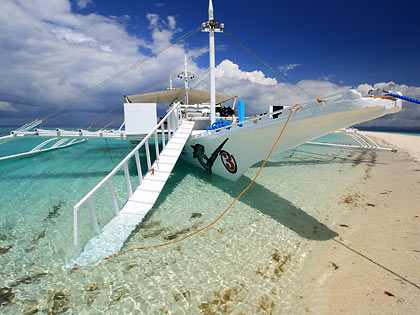
Dive boat from Malapascua at Kalanggaman
Getting There and other Travel Tips
If you're coming directly from places such as Metro Manila the best option is to take the plane to Tacloban which has the nearest domestic airport to Palompon. At Tacloban proper take the van to Palompon – a more-or-less 3 hour travel for P150. Land travel is also an option; there are buses at Cubao, Quezon City and Pasay in Metro Manila that travel directly to Palompon for P1,600. However it is a 27-hour trip. In our case we got discounted plane tickets for Tacloban which costs just a third of the total fare for a two-way bus trip.
Since we were staying in Ormoc for our Leyte tour, we took a commuter van at that city bound for Palompon. The terminal for these vans is located near the Ormoc City Park between Larrazabal St. and the bay walk. Van fare is P110. The vans usually make the trip in 1.5 hours.
After the van drops you off at their terminal in Palompon town proper look for the Palompon Ecotours Office, a yellow structure located beside the municipal hall and in front of the Liberty Park. You need to register at this office prior to your tour of Kalanggaman. The Eco Tours Office is walking distance from the van terminal and the public market but we took the trike to get there. Pump boats going to Kalanggaman are docked at the wharf just behind the Palompon Ecotours Office.
Visitors flying in directly from abroad or local tourists may also take the Cebu City route. Cebu's international airport at Mactan is the nearest international airport to Palompon. At Cebu one can then take a ferry to Palompon (the Super Shuttle Ferry and the Cokaliong Shipping Lines have trips to Palompon daily). Some people traveling from Cebu prefer to take the SuperCat – a fast craft that can make the trip in 2 hours – to go to Ormoc. They can then take a commuter van at Ormoc to get to Palompon as described previously.
It is important that visitors contact the Palompon Ecotours Office to book their trip. The municipality of Palompon is now managing tourism in Kalanggaman and limiting the number of people visiting the island (they actually seem to be doing a good job to preserve Kalanggaman's beauty and make it convenient for tourists at the same time; they've even gotten an award for their work). It is therefore important to make a reservation with them especially during the peak months of April and May. You may contact them at these numbers: 0917-3037267 and 0917-3037269.
The following are the rates for the Kalanggaman day tour:
|
Regular
rate
(day tour) |
Overnight
rate
|
|
| International tourist |
P500
|
P750
|
| Non-Palompon tourist |
P150
|
P225
|
| Non-Palompon college student |
P40
|
P60
|
| Non-Palompon high school student |
P30
|
P45
|
| Non-Palompon elementary student |
P20
|
P30
|
| Non-Palompon senior citizen |
P120
|
P180
|
The pumpboat or motorized outrigger boat rates are as follows:
For boats with a maximum capacity of 15 people: P3,000
For boats with a maximum capacity of 25 people: P3,500
For boats with a maximum capacity of 30 people: P4,000
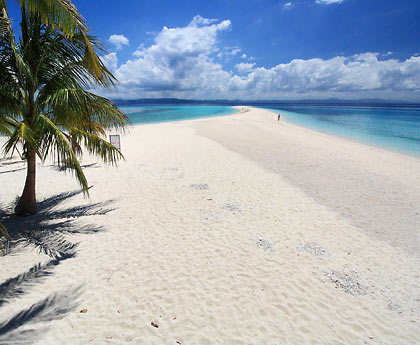
There were only 5 of us on this trip. However, as with other island-hopping trips elsewhere, we had to pay whole for the boat with a maximum capacity of 15. We already knew this beforehand and were prepared to accept these rates. However, a Filipino-American couple was also preparing to go to Kalanggaman at the same time we were. The Palompon tourism people got both of our groups to take the same boat and share the fare, which brought down our expenses considerably. (The couple happily paid P1,000; we took care of the rest. Thanks again to the Palompon folks!) Perhaps one day the tourism people can organize trips to Kalanggaman this way so as to reduce the amount each traveler has to shell out – similar to the system that boat operators at Coron and El Nido in Palawan are using. In the meantime the shoestring traveler way to cut down on your expenses is to recruit several people who will go with you and share the boat fare.
It's best to leave for Kalanggaman aboard the pump boat as early as possible when the waters are calm. 6AM is the earliest possible boat ride. The boat ride usually takes about an hour.
The Palompon Eco Tours people provided us with black garbage bags for use on the island. We had to carry the bags with us on our return trip to Palompon later that day. This only shows that the town is doing its best to preserve Kalanggaman's beauty. At Kalanggaman itself there are open huts one can rent for the day. There are no overnight accommodations unless people are willing to sleep at the open huts. Bring tents if you're planning to stay overnight. The hut rental fees are P250, 500 and 700 depending on the size of the hut.
There are no resorts or restaurants on the island. It is better to bring food and drinks as very little is available for sale at Kalanggaman (we bought packed lunch and drinks at Palompon before boarding our boat for the island). There are at least two grilling stations on the island (on both ends of Kalanggaman) but you have to bring in your own wood or charcoal.
There are a few restrooms scattered around Kalanggaman and some bath rooms as well but fresh water is scarce here. What we did was to just change clothes and take a shower at the Eco Tourism Office back in Palompon. Again we cannot say enough about the tourism staff here who were very accommodating. We also shopped around for souvenirs and even some danggit at the Eco Tourism Office. Back home later we realized how good the danggit was.
It would seem that Kalanggaman is not that developed with no resorts and just the most basic of amenities. We actually prefer it that way and it seems that for the time being the Eco Tourism Office shares the same sentiment and is doing its best to preserve the pristine state of the island.
Visit our Facebook page for even more pictures of Kalanggaman Island.

